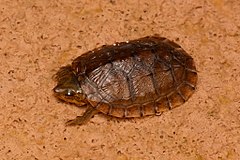Kinosternon
rodzaj żółwia
Kinosternon – rodzaj żółwi z rodziny mułowcowatych (Kinosternidae).
| Kinosternon[1] | |||
| Spix, 1824[2] | |||
 Przedstawiciel rodzaju – K. creaseri | |||
| Systematyka | |||
| Domena | |||
|---|---|---|---|
| Królestwo | |||
| Typ | |||
| Podtyp | |||
| Gromada | |||
| Rząd | |||
| Podrząd | |||
| Nadrodzina |
Kinosternoidea | ||
| Rodzina | |||
| Podrodzina | |||
| Rodzaj |
Kinosternon | ||
| Typ nomenklatoryczny | |||
|
Kinosternon longicaudatum Spix, 1824 (= Testudo scorpioides Linnaeus, 1766) | |||
| Synonimy | |||
|
| |||
| Gatunki | |||
| |||
Zasięg występowania
edytujRodzaj obejmuje gatunki występujące w Ameryce (Stany Zjednoczone, Meksyk, Belize, Gwatemala, Salwador, Honduras, Nikaragua, Kostaryka, Panama, Kolumbia, Trynidad i Tobago, Wenezuela, Gujana, Surinam, Gujana Francuska, Brazylia, Ekwador, Peru, Boliwia, Paragwaj i Argentyna)[9][10].
Systematyka
edytujEtymologia
edytuj- Kinosternon: gr. κινεω kineō „poruszać, ruszać”[11]; στερνον sternon „pierś, klatka piersiowa”[12].
- Monoclida: gr. μονος monos „jeden jedyny”[13]; κλεις kleis, κλειδος kleidos „zasuwa, rygiel”[14]. Gatunek typowy: Monoclida retziana Rafinesque, 1832 (= Testudo scorpioides Linnaeus, 1766).
- Uronyx: gr. ουρα oura „ogon”[15]; ονυξ onux, ονυχος onukhos „pazur, paznokieć”[16]. Gatunek typowy: Testudo scorpioides Linnaeus, 1766.
- Swanka: etymologia niejasna, Gray nie wyjaśnił pochodzenia nazwy rodzajowej[5]. Gatunek typowy: Testudo scorpioides Linnaeus, 1766.
- Platythyra: gr. πλατυς platus „szeroki”[17]; θυρα thura „wejście, drzwi”[18]. Gatunek typowy: Platythyra flavescens Agassiz, 1857.
- Thyrosternum: gr. θυρα thura „wejście, drzwi”[18]; στερνον sternon „pierś, klatka piersiowa”[12]. Gatunek typowy: Testudo pensylvanica J.F. Gmelin, 1789 (= Kinosternon subrubrum Bonnaterre, 1789).
- Cryptochelys: gr. κρυπτος kruptos „ukryty”; χελυς khelus „żółw rzeczny”[8]. Gatunek typowy: Cinosternon leucostomum A.M.C. Duméril, Bibron & A.H.A Duméril, 1851.
Podział systematyczny
edytujDo rodzaju należą następujące gatunki[9]:
- Kinosternon abaxillare Baur, 1925
- Kinosternon acutum J.E. Gray, 1831
- Kinosternon alamosae Berry & Legler, 1980
- Kinosternon angustipons Legler, 1965
- Kinosternon baurii (Garman, 1891)
- Kinosternon chimalhuaca Berry, Seidel & Iverson, 1997
- Kinosternon cora Loc-Barragán, Reyes-Velasco, Woolrich-Piña, Grünwald, Venegas De Anaya, Rangel-Mendoza & López-Luna, 2020
- Kinosternon creaseri Hartweg, 1934
- Kinosternon dunni Schmidt, 1947
- Kinosternon durangoense Iverson, 1979
- Kinosternon flavescens (Agassiz, 1857)
- Kinosternon herrerai Stejneger, 1925
- Kinosternon hirtipes (Wagler, 1830)
- Kinosternon integrum Le Conte, 1854
- Kinosternon leucostomum (A.M.C. Duméril, Bibron & A.H.A. Duméril, 1851)
- Kinosternon oaxacae Berry & Iverson, 1980
- Kinosternon scorpioides (Linnaeus, 1766) – mułowiec skorpionowy[19]
- Kinosternon sonoriense Le Conte, 1854
- Kinosternon steindachneri Siebenrock, 1906
- Kinosternon stejnegeri Hartweg, 1938
- Kinosternon subrubrum Bonnaterre, 1789 – mułowiec pensylwański[19]
- Kinosternon vogti López-Luna, Cupul-Magaña, Escobedo-Galván, González-Hernández, Centenero-Alcalá, Rangel-Mendoza, Ramírez-Ramírez & Cazares-Hernández, 2018
Uwagi
edytuj- ↑ a b Nomen nudum.
Przypisy
edytuj- ↑ Kinosternon, [w:] Integrated Taxonomic Information System (ang.).
- ↑ J.B. von Spix: Animalia nova sive species novae testudinum et ranarum: quas in itinere per Brasiliam annis 1817-1820 jussu et auspiciis Maximiliani Josephi I. Bavariae regis. Monachii: F.S. Hübschmanni, 1824, s. 17. (łac.).
- ↑ a b C.S. Rafinesque: Analyse de la nature, or, Tableau de l’univers et des corps organisés. Palerme: Aux dépens de l’auteur, 1815, s. 75. (fr.).
- ↑ a b C.S. Rafinesque: Description of two new genera of Soft Shell Turtles of North America. W: C.S. Rafinesque: Atlantic journal, and friend of knowledge in eight numbers : containing about 160 original articles and tracts on natural and historical sciences, the description of about 150 new plants, and 100 new animals or fossils; many vocabularies of languages, historical and geological facts, &c. &c. &c. Philadelphia: 1832–1833, s. 64. (ang.).
- ↑ a b J.E. Gray: Catalogue of the tortoises, crocodiles, and amphisbaenians, in the collection of the British Museum. London: The Trustees, 1844, s. 32. (ang.).
- ↑ Agassiz 1857 ↓, s. 420.
- ↑ Agassiz 1857 ↓, s. 418.
- ↑ a b J.B. Iverson, M.D. Le & C. Ingram. Molecular phylogenetics of the mud and musk turtle family Kinosternidae. „Molecular Phylogenetics and Evolution”. 69 (3), s. 933, 2013. DOI: 10.1016/j.ympev.2013.06.011. (ang.).
- ↑ a b P. Uetz & J. Hallermann: Genus: Kinosternon. The Reptile Database. [dostęp 2024-02-06]. (ang.).
- ↑ R. Midtgaard: Kinosternon. RepFocus. [dostęp 2020-09-25]. (ang.).
- ↑ Jaeger 1944 ↓, s. 51.
- ↑ a b Jaeger 1944 ↓, s. 221.
- ↑ Jaeger 1944 ↓, s. 139.
- ↑ Brown 1954 ↓, s. 210.
- ↑ Jaeger 1944 ↓, s. 247.
- ↑ Jaeger 1944 ↓, s. 154.
- ↑ Brown 1954 ↓, s. 617.
- ↑ a b Jaeger 1944 ↓, s. 237.
- ↑ a b Praca zbiorowa: Zwierzęta: encyklopedia ilustrowana. Warszawa: Wydawnictwo Naukowe PWN, 2005, s. 362, 365. ISBN 83-01-14344-4.
Bibliografia
edytuj- L. Agassiz: Contributions to the natural history of the United States of America. Cz. 1. Boston: Little, Brown and Company, 1857, s. 1–452. (ang.).
- Edmund C. Jaeger, Source-book of biological names and terms, wyd. 1, Springfield: Charles C. Thomas, 1944, s. 1–256, OCLC 637083062 (ang.).
- R.W. Brown: Composition of scientific words; a manual of methods and a lexicon of materials for the practice of logotechnics. Washington: Published by the author, 1954, s. 1–882. (ang.).